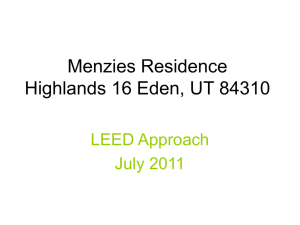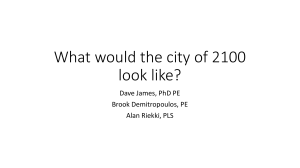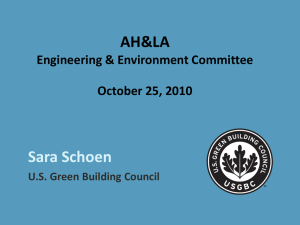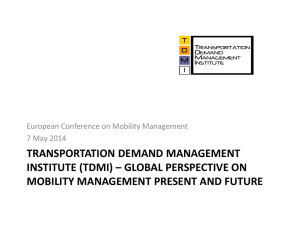1335217641_1 - McLaughlin Brunson Insurance Agency
advertisement
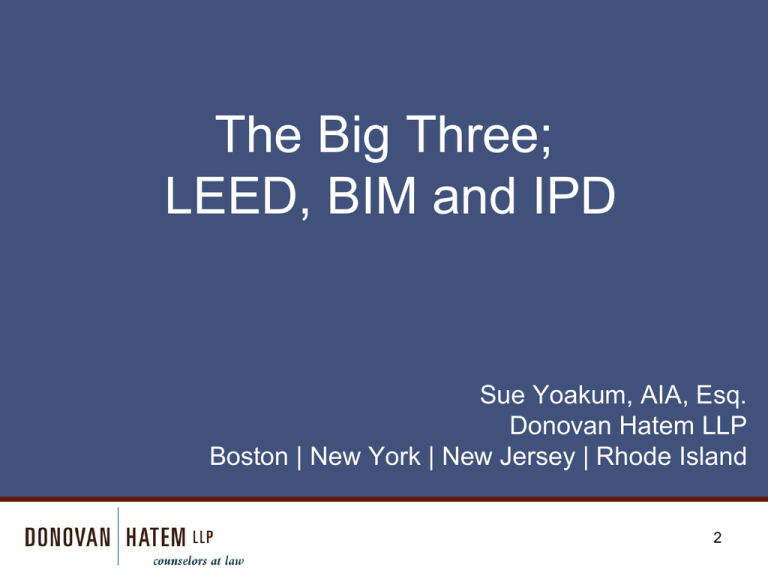
The Big Three; LEED, BIM and IPD Sue Yoakum, AIA, Esq. Donovan Hatem LLP Boston | New York | New Jersey | Rhode Island 2 Welcome Donovan Hatem LLP is an approved Provider with The American Institute of Architects Continuing Education Systems (AIA/CES). Credit earned on completion of this program will be reported to CES Records for AIA members. Certificates of Completion for non-AIA members are available on request. This program is registered with the AIA/CES for continuing professional education. As such, it does not include content that may be deemed or construed to be an approval or endorsement by the AIA of any material of construction or any method or manner of handling, using, distributing, or dealing in any material or product. Questions related to specific materials, methods, and services will be addressed at the conclusion of this presentation. 2 The Big Three; LEED, BIM and IPD • LEED/Green/Sustainable Design, – How to manage this changing risk? • Building Information Modeling (BIM), – What do I need to know and how do I keep it simple? • Integrated Project Delivery (IPD), – Why would I want to do an IPD project if my profits are at risk? 3 GSA • Almost every local, state and federal building programs are adopting green building requirements with LEED certification leading the way • Looking at the GSA –2000 - All capital project LEED certified –2007 - All leased construction LEED Silver –2009 - LEED Silver required –2010 - LEED Gold Difficult to keep up with moving LEED/Sustainability/Green requirements. However, it is difficult to impossible to defend if such a requirement is missed. 4 Green Building Programs • Other concerns: “Taking the Pledge” in Washington D.C. – In 2007, Washington, D.C. passed the Green Building Act of 2006 and became the first major U.S. city to impose green building standards on private projects. – The final phase of the Act will take effect January 1, 2012 requiring new or substantially renovated nonresidential buildings over 50,000 s.f. obtain LEED certification and applicants are required to post up to a $3 million performance bond guaranteeing the Act’s green requirements will be met. 5 Green Building Programs – On November 1, 2011, an alternative to posting this bond was proposed. Owners could opt out of the bond requirements by signing a pledge that the project would meet the Act’s requirements subject to a penalty up to $3 million for non compliance. – For design professionals working in the D.C. area, this may result in Owner’s requiring guarantees of LEED certification and unreasonable contract terms. 6 Green Building Programs • Looking at IGCC – International Green Construction Code – It claims to be an adoptable, useable and enforceable code – Applicable to construction of new and existing buildings and residential buildings – Not a rating system, but an adoptable code – Intended to make all buildings measurably greener, not a few buildings very green – Development schedule • First edition of the IGCC published in March 2012 7 Tax Deductions From IRS • EPAct Energy Policy Act of 2005 – Tax deduction for energy efficient buildings – EPAct provides tax deduction of up to $1.80 per s.f. of building investments that achieve specified energy cost reductions beyond ASHRAE 90.1-2001 – Deductions of up to $.60 s.f. are available for three types of building systems, 1) lighting including lighting controls, 2) HVAC and 3) building envelope which includes roof, walls, windows doors and floor/foundation – For projects placed in service after Dec. 31, 2005 and before Jan. 1, 2013 – Possible to assign tax deduction on government projects to designers or constructors of the system 8 LEED V.3 Online Registration Concerns • GBCI’s Agreements released in January 2011 including the following: 1) Confirmation of Agent’s Authority - Version 1, Released January 11, 2011, and revised June 2011 2) Terms and conditions for The Use of LEED® Online Version 3, Released January 11, 2011 3) LEED® Project Registration Agreement - Version 5, Released January 11, 2011 4) LEED® Project Certification Agreement - Version 4, Released January 11, 2011 9 LEED V.3 Online Registration Concerns Confirmation of Agent’s Authority Version 1 – Released January 11, 2011 and revised in June 2011, both are good January 2011, is preferred • Parties to this Agreement are the Design Professional, Owner and GBCI • Include this Agreement as an Exhibit to your Professional Services Agreement for LEED projects • This Agreement is critical because the Owner will most likely require you to register the LEED Project and you cannot without shifting the risks and liabilities found in the collection of the GBCI Agreements/Policy Manual back to the Owner 10 LEED V.3 Online Registration Concerns Confirmation of Agent’s Authority - January 2011, “Article 5, Scope of Agent’s Authority. Owner has expressly granted Agent the full legal right and authority to take any and all actions Agent deems necessary or advisable in connection with the LEED certification process, with the express understanding and intent that Owner shall be lawfully bound by any such actions taken by Agent and with the same legal effect as if taken directly by Owner.” 11 LEED V.3 Online Registration Concerns Confirmation of Agent’s Authority - January 2011, “10. Liability of Owner. Owner, and not the Agent, shall be solely and fully liable for any error, omission, misrepresentation, breach of contractual obligations or other wrong or damage arising from the actions of Agent on Owner’s behalf, as such liability may be more fully set forth in the documentation for the LEED certification process. GBCI and Owner acknowledge that the definition of “you” in the LEED Project Registration Agreement, the LEED Certification Agreement, the LEED Project Application Review Agreement and/or the LEED Volume Certification Service and Licensing Agreement, as entered into by Agent, applies only to Owner and not to Agent.” 12 Sample “Green” Contract Clauses • Relating to LEED online V.3 registration “The Owner agrees they will review and execute any and all agreements that are a part of the LEED certification process and be responsible for the LEED application including the Confirmation of Agent’s Authority Agreement with the Design Professional. If the Owner disagrees with any agreement that is a part of the LEED certification, the Owner can, in its sole discretion, decide to discontinue LEED certification for the Project. Owner agrees to waive any and all claims and damages, including consequential damages against the Design Professional if the Owner determines they are no longer seeking LEED certification.” 13 AIA “Green” Documents and Agreements • AIA has a relatively new document the D503-2011 which is a Guide to Sustainable projects • AIA intends to release the following “Sustainable” Agreements in May 2012: 1) A101 – 2007 SP Standard Form of Agreement Between Owner and Contractor for use on a Sustainable Project where the basis of payment is Stipulated Sum 2) A201 – 2007 SP General Conditions of the Contract for Construction, for use on a Sustainable Project 3) A401 – 2007 SP Standard Form of Agreement Between Contractor and Subcontractor, for use on a Sustainable Project 4) B101 – 2007 SP Standard Form of Agreement Between Owner and Architect for use on a Sustainable Project 5) B 214 – 2012 Standard Form of Architect’s Services: LEED Certification 6) C401 – 2007 SP Standard Form of Agreement Between Architect and Consultant, for use on a Sustainable Project 14 Building Information Modeling (BIM) • What do I need to know and how do I keep it simple? • Set Expectations • Organization, hosting and administration of the Building Information Models – who is responsible? – Who, how and where for Design Team? – Who, how and where for Build Team? – Who, how and where for Owner’s management after construction? • Use Agreements to assist in setting expectations – Digital Data Transfer Agreement, and – BIM execution plan 15 Building Information Modeling (BIM) • Manage expectations relating to the information in the BIM models: – Clearly define the level of development of the BIM models by each member of the design team during each phase of design – Clearly define who can use the BIM models and for what uses – Stress the need for the Contractor and its subcontractors to use BIM models for their documents, including shop drawings – Clarify that the design teams’ models can be used by the Contractor and its subcontractors as a reference only, but the Contractor and its subcontractors will need to develop their own BIM models to assist with their Work – Clarify the Design Professional’s Construction Documents and specifications are the controlling documents 16 Building Information Modeling (BIM) • Setting expectations for development and use of the BIM models. The following are needed: – AIA E 202 – 2008 BIM Protocol Exhibit, intended to be attached to your Agreements with the Owner and Consultants – AIA E 201 – 2007 Digital Data Agreement, intended to be attached to your Agreements with the Owner and Consultants, or – AIA C 106 2007 – Digital Data Licensing Agreement • Two party agreement that creates a license to use the digital data for a project. This agreement is anticipated to be used between parties that do not have an agreement, i.e. contractor or subcontractors. AIA is working on updating the E202 and E201. Anticipate publication sometime in 2012. 17 Integrated Project Delivery (IPD) • There continues to be significant talk about IPD. If you exclude California, however, few projects are using IPD. • If you eliminate hospital projects, the number reduces further. 18 Integrated Project Delivery (IPD) • Why would I want to do an IPD project if my profits are at risk? – What is considered a “Pure” IPD project? Multi-parties execute one Agreement and promise to deliver the Project pursuant to agreed upon terms and conditions, including defining the budget and schedule – Parties to an IPD Agreement typically include the Owner, Architect, CM or General Contractor, and can include major design subconsultants and major subcontractors – Payment: typically, design team and contractor are paid their costs, plus some or all of their overhead and an agreed-upon profit – The IPD form agreements places profit at risk if the Project cannot be delivered as anticipated – What percentage of profit is typical to risk? Completely negotiable from 100% to lesser agreeable amount 19 Integrated Project Delivery (IPD) • Why would I want to do an IPD project if my profits are at risk? – The parties work together and create a process (Core Team) to understand, design, estimate costs and schedule, and make decisions for the project • This does not mean that quality design or construction is at risk. Design and construction options are evaluated by the team in and effort to make the best decision for the project. – Owner carries a contingency that the “Core Team” has available for use on the Project– “the IPD Core Team Contingency” – If contingency is preserved, it can be used as incentive payment and shared among the project participants – If contingency exhausted, project participants make up the difference up to a certain limit . . . there goes your profit 20 Integrated Project Delivery (IPD) • A look at the money for a $100 million project – IPD Core Team Contingency suggested at five percent (5%) of hard construction cost, or $5 million • Suggest a waiver of claims from the Owner within the IPD Core Team Contingency – Owner’s Contingency, suggested at five percent (5%) an additional 5%, or $5 million for certain Owner costs, increase scope, unforeseen conditions, etc. – Total Contingencies are $10 million 21 Integrated Project Delivery (IPD) – After depletion of the IPD Core Team Contingency, Owner looks to design professionals and GC/CM to pay a portion of profits they agreed by contract to have at risk – After depletion of profits at risk . . . well the same old claim game with deductible and insurance at risk – Of concern is the potential disconnect between professional liability insurance and the IPD multi-party agreement 22 Integrated Project Delivery (IPD) – Professional insurance is triggered on fault, i.e. a finding of negligence on the part of the design professional – Giving back a part of your profit per your IPD Agreement is not triggered on your fault, or negligence, it is a contractual obligation • Does this profit given back count towards your deductible? • Not unless you insurance provider agrees • Can professional liability insurance and IPD live together? • Yes project specific professional policy is the best fit 23 Conclusion • Green/Sustainability/LEED, BIM and IPD continue to dominate the design landscape and are changing the practice of architecture and engineering. This is not the first time, nor will it be the last that, the professions experience change. • How will your firm handle this changing landscape? 24 Contact Information Sue E. Yoakum, Esquire, AIA syoakum@donovanhatem.com Donovan Hatem LLP World Trade Center East Two Seaport Lane Boston, MA 02210 Tel 617.406.4674 Fax 617.406.4501 25 Donovan Hatem LLP © 2012 01440008 26



